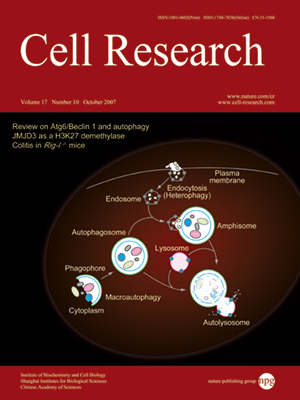Volume 17 Issue 10, October 2007: 858-868
ORIGINAL ARTICLES
Rig-I-/- mice develop colitis associated with downregulation of Gαi2
Yi Wang1,*, Hong-Xin Zhang1,*, Yue-Ping Sun1, Zi-Xing Liu1, Xue-Song Liu1, Long Wang2,3, Shun-Yuan Lu2,3, Hui Kong3, Qiao-Ling Liu3, Xi-Hua Li1, Zhen-Yu Lu1, Sai-Juan Chen2, Zhu Chen2, Shi-San Bao4, Wei Dai5 and Zhu-Gang Wang1,2,3,4
1Department of Medical Genetics, Shanghai Jiao Tong University School of Medicine, Shanghai 200025, China
2State Key Laboratory of Medical Genomics, Rui-Jin Hospital Affiliated to Shanghai Jiao Tong University School of Medicine, Shanghai 200025, China
3Shanghai Research Center for Model Organisms, Shanghai 201203, China
4Department of Pathology, University of Sydney, Sydney, 2570 NSW, Australia
5Department of Environmental Medicine, New York University School of Medicine, Tuxedo, NY 10987, USA
Correspondence: Zhu-Gang Wang(zhugangw@shsmu.edu.cn)
RIG-I (retinoid acid-inducible gene-I), a putative RNA helicase with a cytoplasmic caspase-recruitment domain (CARD), was identified as a pattern-recognition receptor (PRR) that mediates antiviral immunity by inducing type I interferon production. To further study the biological function of RIG-I, we generated
Rig-I-/- mice through homologous recombination, taking a different strategy to the previously reported strategy. Our
Rig-I-/- mice are viable and fertile. Histological analysis shows that
Rig-I-/- mice develop a colitis-like phenotype and increased susceptibility to dextran sulfate sodium-induced colitis. Accordingly, the size and number of Peyer's patches dramatically decreased in mutant mice. The peripheral T-cell subsets in mutant mice are characterized by an increase in effector T cells and a decrease in naïve T cells, indicating an important role for Rig-I in the regulation of T-cell activation. It was further found that
Rig-I deficiency leads to the downregulation of G protein αi2 subunit (Gαi2) in various tissues, including T and B lymphocytes. By contrast, upregulation of
Rig-I in NB4 cells that are treated with ATRA is accompanied by elevated
Gα
i2 expression. Moreover,
Gα
i2 promoter activity is increased in co-transfected NIH3T3 cells in a Rig-I dose-dependent manner. All these findings suggest that Rig-I has crucial roles in the regulation of
Gα
i2 expression and T-cell activation. The development of colitis may be, at least in part, associated with downregulation of
Gα
i2 and disturbed T-cell homeostasis.
Cell Research (2007) 17:858-868. doi: 10.1038/cr.2007.81; published online 25 September 2007
FULL TEXT | PDF
Browse 1904


